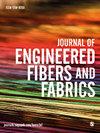Removal of Basic Fuchsine (BF) in aqueous solution by Adsorption Process onto ‘Prunus Cerasefera’ (LPC) - Kinetics, Isotherm modeling and Thermodynamic Study
IF 2.3
4区 工程技术
Q1 MATERIALS SCIENCE, TEXTILES
引用次数: 1
Abstract
The Leaves Pruna Cerasefera (LPC) was developed for the adsorption of Basic Fuchsin (BF) from its aqueous solution. LPC with a specific surface area of 22 m2/g was characterized by the BET surface area, Fourier transform infrared spectroscopy (FTIR), and pH of zero point charge pHpzc (=6.80). The adsorptive properties of LPC with BF was conducted at variable stirring speed (100–1000 rpm), adsorbent dose (2–16 g/L), solution pH (2–10), initial BF concentrations (100–200 mg/L), contact time (0–60 min), and temperature (295–313 K) using batch mode operation to find the optimal conditions for a maximum adsorption. The adsorption mechanism of BF onto LPC was studied using the first pseudo order and second pseudo order kinetic models. The BF elimination was found to follow a pseudo-second order kinetic model with a determination coefficient (R2) of 0.999. The experimental data were fitted to Langmuir, Freundlich, Temkin, and Elovich isotherms, and the equilibrium behavior explained by the Langmuir model provides the best correlation (qmax = 158.73 mg/g, R2 = 0.999 at 25°C). The effect of adsorption at different temperatures have been studied for the determination of thermodynamic parameters, that is, the free energy (ΔG° = −5.4437 to −4.5879 kJ/mol), enthalpy (ΔH° = −19.469 kJ/mol), and entropy (ΔS° = −0.4554 kJ/mol K). The negative values of ΔG° and ΔH° values that the overall adsorption is spontaneous and exothermic in nature. Our work has a dual environmental aspect; on the one hand the valorization of a natural by-product namely LPC, and on the other hand, the elimination of BF from aqueous solutions. The present adsorbent may be considered as an alternative adsorbent for the better performance of the BF removal from its aqueous medium.樱桃李(LPC)吸附去除水溶液中碱性品红的动力学、等温模型和热力学研究
为吸附碱性品红(BF),研制了樱桃叶(LPC)。比表面积为22的LPC 通过BET表面积、傅立叶变换红外光谱(FTIR)和零点电荷pH值pHpzc(=6.80)表征了LPC与BF的吸附性能 rpm),吸附剂剂量(2-16 g/L)、溶液pH(2-10)、初始BF浓度(100-200 mg/L),接触时间(0-60 min)和温度(295–313 K),以找到最大吸附的最佳条件。采用一阶和二阶动力学模型研究了BF在LPC上的吸附机理。BF消除遵循伪二阶动力学模型,确定系数(R2)为0.999。实验数据符合Langmuir、Freundlich、Temkin和Elovich等温线,Langmuir模型解释的平衡行为提供了最佳相关性(qmax = 158.73 mg/g,R2 = 25°C时为0.999)。为了确定热力学参数,研究了不同温度下吸附的影响,即自由能(ΔG° = −5.4437至−4.5879 kJ/mol),焓(ΔH° = −19.469 kJ/mol)和熵(ΔS° = −0.4554 kJ/mol K)。ΔG°和ΔH°的负值表明整体吸附是自发的和放热的。我们的工作具有双重环境方面;一方面是天然副产物LPC的增值,另一方面是从水溶液中消除BF。本吸附剂可以被认为是一种替代吸附剂,用于从其水介质中更好地去除BF。
本文章由计算机程序翻译,如有差异,请以英文原文为准。
求助全文
约1分钟内获得全文
求助全文
来源期刊

Journal of Engineered Fibers and Fabrics
工程技术-材料科学:纺织
CiteScore
5.00
自引率
6.90%
发文量
41
审稿时长
4 months
期刊介绍:
Journal of Engineered Fibers and Fabrics is a peer-reviewed, open access journal which aims to facilitate the rapid and wide dissemination of research in the engineering of textiles, clothing and fiber based structures.
 求助内容:
求助内容: 应助结果提醒方式:
应助结果提醒方式:


